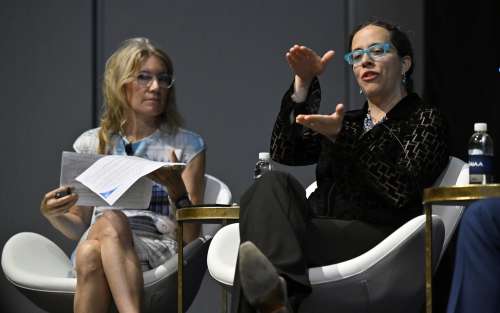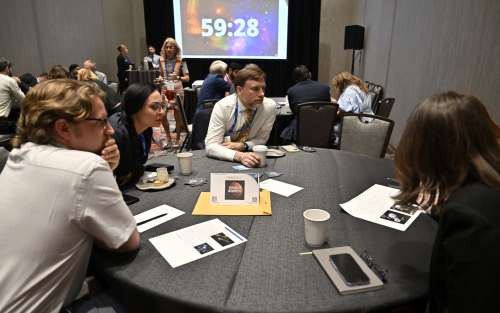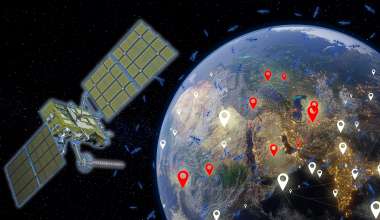Space sector leaders recently took center stage at the American Institute of Aeronautics and Astronautics (AIAA) ASCEND 2025 conference in Las Vegas, spearheading discussions on key topics that are shaping a space enterprise that is increasingly exploiting growing commercial capabilities. At the forefront of this event, The Aerospace Corporation fostered dialog, created new partnerships and lit the path for the next generation of professionals.
ASCEND serves as a vital crossroads for the U.S. civil, commercial and national security space sectors, particularly as transitioning policies and evolving threats are spurring industry, government and academia to reevaluate how they collaborate to solve the challenges that come with accelerating activity in orbit.
“American space leadership depends on harnessing the combined energy of commercially oriented firms as well as traditional government-led programs, and it can do that in support of civil, scientific and national security objectives,” said Jamie Morin, vice president of Defense Strategic Space and executive director of the Center for Space Policy and Strategy at Aerospace. “Doing that in a way that is ethical, legal and economically sound requires continued policy innovation.”
“Buy a Little, Try a Little, Buy a Lot More”
With its unique position at the nexus of commercial innovation and government mission execution, Aerospace is a critical enabler of forward-looking solutions that strengthen U.S. leadership in space. Throughout the conference, Aerospace experts engaged in forward-thinking discussions spanning security and defense, space science and exploration, and aligning standards for responsible space operations with stronger, longer-term economic potential.
A central theme of Aerospace’s participation at ASCEND was the nation’s need to leverage rapid acquisition and deployment practices to stay ahead of threats, enable new capabilities, and deliver end-to-end solutions to users—whether operators, scientists, or warfighters—faster and with greater agility throughout mission lifecycles.
Morin, who delivered ASCEND's prestigious David W. Thompson Lecture in Space Commerce, proposed a more agile approach to acquisitions of new commercial capabilities that prioritizes quicker deployment of useful capabilities to space, versus waiting longer for more polished capabilities to be ready.
“Predicting future needs is hard when there are a lot of sources of innovation out there,” Morin said regarding the integration of new commercial capabilities. “We’ve got to figure out how to adopt an approach to buy a little, try a little, and buy a lot more, and that’s a different way to do contracting. We can have lower barriers to 'buy a little' than we do for 'buy a lot,' and we need to embrace that and use that for speed.”
Commercial Can Do That
Commercial capabilities increasingly show their value and potential roles in major national goals, such as implementing and integrating next-generation, space-enabled defense systems and charting a course from the Moon to Mars. This emphasis permeated ASCEND discussions ranging from rapid capability deployment to space science, which Aerospace led both as a thought leader and an operational bridge between the commercial and government space sectors.

Aerospace-convened panels tackled hard problems which commercial players are taking leading roles in addressing, including efforts to mitigate light and frequency pollution caused by satellites (“dark and quiet skies”), the preservation of critical spectrum bands, the resilience of GPS systems and delivering commercial LEO stations as future destinations for human presence in space. From the solutions side, these conversations brought to the forefront commercial advances in artificial intelligence, data analysis, high-performance computing and the use of testbeds and proving grounds to build confidence in new capabilities.
Commercial companies are also poised to take on leading roles in maintaining momentum on national space science priorities — the topic of ASCEND’s Thursday keynote panel arranged and moderated by Uma Bruegman, assistant general manager of the Strategic Assessments, Studies and Projects (SASP) division at Aerospace and executive director of the Space Safety Institute.
“The commercial sector undoubtedly has a role to play in implementing science and research programs in space, and they’re showing interest in doing so,” said Bruegman. “We need to find new ways to collaborate and align efforts. Using venues like ASCEND we can kickstart that collaboration across research disciplines and organizations to maintain momentum on national priorities.”
Innovative Solutions to Hard Space Problems

Beyond panels and speeches, Aerospace experts brought technical insight paired with the strategic perspective necessary to navigate a rapidly changing space environment—one where agility, collaboration and innovation are the keys to enduring success.
Aerospace presented technical papers and hosted workshops that explored emerging technologies, dissected market and policy trends and fostered collaborative problem-solving. These sessions provided a forum to connect innovators across sectors, aiming to accelerate the advancement of concepts into operational capabilities, such as:
- Common digital engineering environments for evolving space ecosystems, including cislunar space, leveraging innovations like the Aerospace Cislunar Modeling Environment and similar emerging commercial tools
- A technical blueprint for the space industry to develop an in-space rescue capability, which Aerospace presented along with a companion tabletop exercise by Aerospace’s Strategic Foresight team that navigated hypothetical rescue scenarios in low Earth orbit, on the lunar surface and en route to Mars, set in the year 2050
- BLINKER — a maturing prototype transponder to simplify space traffic coordination that was initially flown to orbit on Aerospace’s Slingshot-1 prototype satellite
- Model-based systems engineering tools for NASA’s development of a Moon to Mars Architecture

A common theme among each of these concepts is how they address respective technical disciplines and challenges that require enterprise-level integration and solutions to be truly effective in maintaining American superiority in space. The nation has bold objectives for space — a domain marked less by individual satellites and space actors than by evolving ecosystems involving myriad players. Lori Gordon, systems director in the Space Enterprise Evolution Directorate at Aerospace, summed up a winning approach neatly from the ASCEND stage:
“We want to make sure that we’re discussing the role of all decision makers—acquirers, insurers, investors, researchers, regulators, because integration is more complex and more critical than ever,” said Gordon. “Ecosystems are at the top of the system-of-systems pyramid. Integration is most needed there, and it’s where we must focus to achieve the next great leaps in space.”





